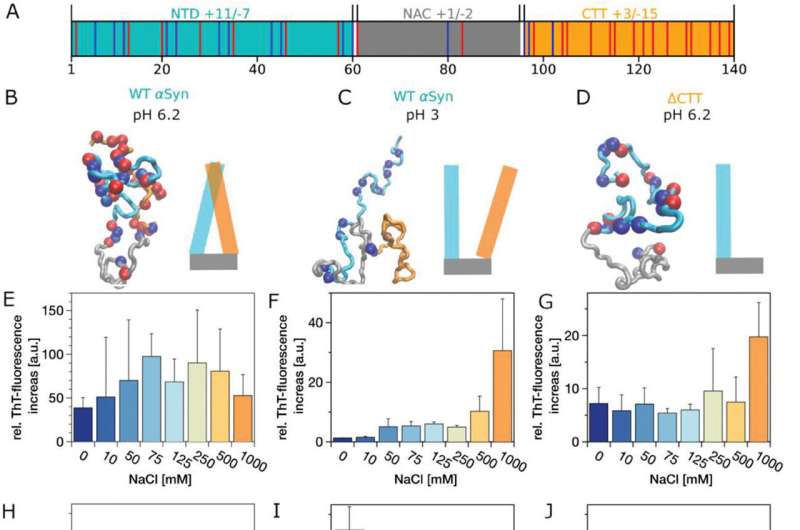This article has been reviewed according to Science X's editorial process and policies. Editors have highlighted the following attributes while ensuring the content's credibility:
fact-checked
peer-reviewed publication
trusted source
proofread
Protein droplets likely don't cause Parkinson's, study suggests

Liquid-liquid phase separation is not a precursor to formation of amyloid fibrils, a pathological hallmark of Parkinson's disease, shows a recent study. Rather, the formation of protein into liquid droplets may help to dissolve aggregated protein. The study, published in the journal Advanced Science, deepens our understanding of neurodegenerative diseases linked to protein aggregation and could help develop new therapies.
Add vinegar to oil and shake: droplets of oil form. The concept of liquid-liquid phase separation has been known in everyday life for generations, but its existence in the cell has developed into one of the hottest topics in biology.
Fifteen years ago, it was discovered that protein molecules could condense into droplets, isolated from the cell's cytoplasm without an external membrane. In roundworm embryos, proteins and RNA were found to form tiny droplets that help manage genetic material during early growth stages.
This discovery gave birth to a new way of thinking about the cell. Optimized by evolution, liquid-liquid phase separation could be highly functional. Such droplets could allow cells to compartmentalize molecules and regulate biochemical reactions.
Now with eyes opened to the possibility, researchers have found them everywhere: in the nucleus helping to organize DNA, forming stress granules to protect and regulate mRNA and at the ends of microtubules, acting as a smart molecular glue to position the nucleus for cell division.
As well as their functional significance, droplets have been implicated in disease. In the case of neurodegenerative diseases characterized by the formation of protein aggregates, such as Alzheimer's and Parkinson's, it has been supposed that protein droplets are a precursor to pathological protein aggregation.
The idea behind this theory is that droplets can concentrate certain proteins, and this could push them to the point of aggregation. Backing it up are numerous observations that certain conditions such as salt concentration or pH simultaneously promote protein aggregation and condensation. Yet whether—or, indeed how—the two are linked remains unproven.
Now, in the most comprehensive exploration yet of the relationship between aggregation and liquid-liquid phase separation, a research team led by Paul Scherrer Institute PSI has found that droplet formation does not cause aggregation; in contrast, it may protect from it.
Five hundred conditions
Researchers investigated the protein alpha-synuclein (ɑSyn), which clumps together to form the amyloid fibrils that eventually lead to cell death in patients with Parkinson's disease.
To pin down the true link between aggregation and droplet formation, the researchers methodically investigated the behavior of ɑSyn proteins under a wide variety of conditions: protein concentration, salt concentration and the presence of various concentrations of crowding agents that mimic the complex molecular environment of the cytoplasm. Each of these were studied at different pH values.
In total, the researchers studied more than five hundred different conditions. For each condition, they followed the progression of droplet formation or aggregation for up to four months, taking regular images using light microscopy.
To study so many conditions, the researchers used the robotic crystallization facility at the Swiss Light Source SLS. The technique is typically used to prepare protein crystals for X-ray crystallography experiments.
"Being at the large-scale facilities and working alongside beamline scientists enabled us to approach this problem from a different angle," explains PSI postdoctoral researcher Rebecca Sternke-Hoffmann, first author of the study.
"Interestingly, crystallographers have known that proteins could form droplets for a very long time. It was just another thing they observed in their search for the perfect crystal," adds PSI scientist Jinghui Luo, who led the study.
To complement this macroscopic story, the researchers used small angle X-ray scattering (SAXS) measurements at the Swiss Light Source SLS and conducted simulations to understand the microscopic picture.
Vinegar in oil and vinegar in milk are different processes
The meticulous experiments revealed that the conditions that give rise to stable droplets or protein aggregation are not the same. Contrary to conventional theory that aggregates initiate from droplets, the researchers showed independent formation of droplets and aggregates in αSyn across diverse protein, salt and crowding conditions.
Through their long time-frame of investigation, the researchers could see whether droplets really did evolve into aggregates. The answer: they didn't, even after one hundred and twenty days. Indeed, far from promoting aggregation into fibrils, remarkably droplets appeared to have the opposite effect. During extended incubations, previously considered irreversible fibrils transformed into droplets.
"This observation points to a functional role of liquid droplets in preventing the formation of solid aggregates under specific conditions," says Luo. Current understanding of liquid-liquid phase separation in the cell identifies it as a highly evolved feature associated with functionality, whereas aggregation, particularly in the case of αSyn, is associated with disease.
"From this perspective, it would be somewhat surprising if protein droplets were precursors of protein aggregation," he suggests.
Through SAXS measurements together with simulations and sequence analysis, the researchers could understand the differences they observed: aggregation occurs mostly due to interactions between the tails of individual protein molecules, while liquid-liquid phase separation occurs due to interactions between different protein molecules.
To relate the discovery to the analogy of oil and water: add vinegar to oil and the oil forms droplets. Add vinegar to milk and hard aggregates of the protein form. Although vinegar is the culprit in both cases, very different processes govern aggregation and droplet formation.
The deeper understanding of the complex interplay between protein aggregation and liquid-liquid phase separation is relevant not only for Parkinson's, but also other neuro-degenerative diseases characterized by protein aggregation, including Alzheimer's, Huntingdon's, and Creutzfeldt-Jakob disease. In turn, this could lead to new treatments.
More information: Rebecca Sternke‐Hoffmann et al, Phase Separation and Aggregation of α‐Synuclein Diverge at Different Salt Conditions, Advanced Science (2024). DOI: 10.1002/advs.202308279


















